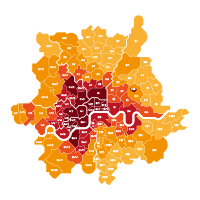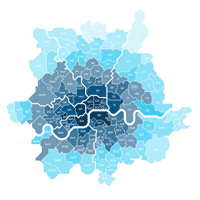Where to Live in London
London is huge. Finding an appropriate area to live in London, that is suitable in terms of budget, character and accessibility to where you work and play, can be a daunting task.
London is more a collection of many towns and villages than a single city centre. When finding accommodation in London, you will find that people refer to areas in many different ways: by their name; postcode; travel zone; borough or even whether they are "North of the River" or "South of the River"
London Postcodes
London is a postcode obsessed place, so it helps to know a bit about London postcodes. We've put together a list of London Postcodes as well as a London Postcode Map (which is also colour coded by average rent prices).
London Boroughs
London is divided into boroughs. Borough councils run the local schools, parks, parking, etc and of course, charge you for 'council tax'. As a young renter, borough issues are less likely to effect you, but when it comes to starting a family (when the quality of local schools becomes important) or buying a property, what borough a property falls in, may influence your decision on where to live.
North or South of the River?
If you've read our guide to London Postcodes you'll know that postcodes are prefixed with SW (for South West), SE (for South East), E (East), N (You get the idea), NW and W. But just to confuse matters, being in an SW postcode does not necessarily mean you're south of the River Thames! All SE postcodes are as well as all SW ones except for SW1 SW3, SW5, SW6, SW7 and SW10. Though both sides of the River contain many and varied areas, there is a definite North South attitude - some might say a North South divide - and most Londoners feel they belong on one side or the other.
Where are the cheapest places to live in london?
 See our average rent map of London to see which postcodes you can afford, or see our list of the 20 cheapest areas to live in London.
See our average rent map of London to see which postcodes you can afford, or see our list of the 20 cheapest areas to live in London.
London by Zone
The famous London Tube Map is divided into zones, from 1 (most central) to 6 and beyond, and the cost of your journey is based on what zones you cross. So if you work in zone 1, you pay less to get there from zone 2 than from zone 6, but you may find the rents are significantly less in zone 6. So deciding where to live is a trade off of those costs, and of course your time spent commuting.
 We've created a handy map which shows postcodes by what zone(s) they're in. It's an approximation because zones are tied to stations rather than postcodes, but it's a good starting point.
We've created a handy map which shows postcodes by what zone(s) they're in. It's an approximation because zones are tied to stations rather than postcodes, but it's a good starting point.
See our London search page to find rooms by commute time to your workplace, by travel zone, by tube line or by location.
Where to Live Wizard
Using over 40,000 comments from over 15,000 of our users, we have created a tool to help you find the right place to live based on the character of the area. For instance, find a neighbourhood that is Bohemian and Good for pubs within your rental budget. Try our Where to Live Wizard
